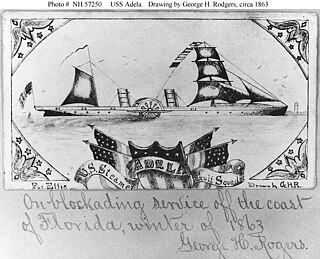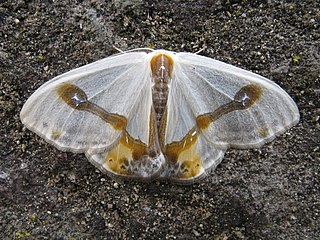
Sarracenia purpurea, commonly known as the purple pitcher plant, northern pitcher plant, turtle socks, or side-saddle flower, is a carnivorous plant in the family Sarraceniaceae.

The green longhorn is a lepidopteran from the moth family Adelidae, the fairy longhorn moths.

USS Adela (1862) was a steamer captured by the Union Navy during the American Civil War. She was used by the Union Navy as a gunboat in support of the Union Navy blockade of Confederate waterways.

The brown-dotted clothes moth is a species of tineoid moth. It belongs to the fungus moth family (Tineidae), and therein to the nominate subfamily Tineinae. It is the type species of its genus Niditinea.
Elusa is a genus of moths of the family Noctuidae erected by Francis Walker in 1859.
Gyrtona is a genus of moths of the family Noctuidae first described by Francis Walker in 1863.

Archips semiferanus is a species of moth in the family Tortricidae, and one of several species of moth commonly known as oak leafroller or oak leaf roller. The larvae feed on the leaves of oak trees in the eastern United States and southeastern Canada and are a major defoliator of oak trees, which can lead to tree mortality. In Pennsylvania in the late 1960s and early 1970s, oak leafrollers defoliated over 1,045,000 acres (423,000 ha).

Pyrrhia cilisca is a moth of the family Noctuidae. Pyrrhia adela was placed as a synonym of Pyrrhia cilisca. Pyrrhia adela was introduced as the new scientific name for the North American population of moths which was formerly considered to be Pyrrhia umbra, hence both species have the common name bordered sallow, although adela was also referred to as the American bordered sallow. It is found from Newfoundland west to Manitoba, South Carolina west to Texas.

Adela is a genus of the fairy longhorn moth family (Adelidae). Among these, it belongs to subfamily Adelinae.

The Chrysauginae are a subfamily of snout moths. They are primarily Neotropical and include about 400 described species.

Nemophora bellela is a moth of the Adelidae family. It is the only circumpolar species of the Nemophora, and the only representative of the genus in North America, where it is found from Quebec across Canada north of the plains to the mountains of British Columbia and Alaska.

Macrocilix mysticata is a moth in the family Drepanidae first described by Francis Walker in 1863. It is found in India, Myanmar, Taiwan, Japan and China.
Adela caeruleella, the southern longhorn moth, is a moth of the family Adelidae or fairy longhorn moths. It was described by Francis Walker in 1863. It is found in North America, including Alabama, Arkansas, Florida, Illinois, Kentucky, Louisiana, Maryland, Mississippi, North Carolina, Ohio, Oklahoma, Pennsylvania, South Carolina, Tennessee, Texas, Virginia and West Virginia.
Adela ridingsella, Ridings' fairy moth, is a moth of the Adelidae family or fairy longhorn moths. It was described by James Brackenridge Clemens in 1864. It is widespread in eastern North America, from Nova Scotia, Ontario, Quebec and Maine to Pennsylvania and the mountains of North Carolina.
Adela singulella is a moth of the family Adelidae or fairy longhorn moths. It was described by Walsingham in 1880. It is found in California, where it is known from southern Mendocino, Napa and northern Marin Counties. It is also found on the west slope of the Sierra Nevada from El Dorado to Kern County, in the Coast Ranges of Santa Clara County southward, to San Luis Obispo County and then into the San Gabriel Mountains.
Choristoneura albaniana is a moth of the family Tortricidae. It was described by Francis Walker in 1863. In North America it is found from Alaska to Newfoundland, south through the mountains to California, Maine and New Hampshire. It is also found in the northern parts of the Palaearctic region, where it has been recorded from Sweden, Finland, Russia. The habitat consists of forests in boreal and mountainous regions.
Rupela tinctella is a moth in the family Crambidae. It was described by Francis Walker in 1863. It is found in Florida, Georgia, Louisiana, Mississippi, North Carolina, South Carolina, Texas, Mexico, Cuba, the Guianas, Trinidad, Brazil (Paraná), Paraguay and northern Argentina.

Hydriomena divisaria, the black-dashed hydriomena moth, is a moth in the family Geometridae. It is found in North America, where it has been recorded from southern Canada and the northern United States, south to Georgia in the east.

Austramathes purpurea is a species of moth in the family Noctuidae. It was first described by Arthur Gardiner Butler in 1879 from a specimen collected in Otago. It is endemic to New Zealand.














